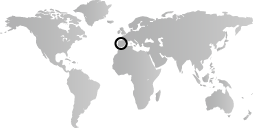This period marks a significant turn in the tide of fortunes for the Iberian Peninsula. The English defeat of the Spanish Armada in 1588 is the first of several debilitating blows to Spanish authority suffered by the country in the warfare with which the period is rife. Nevertheless, the artistic life of Spain flourishes, and the seventeenth and eighteenth centuries produce the greatest masters of the Spanish school. Monarchs avidly patronize native artists as well as Flemish and Italian masters, as lavish displays of pomp and splendor are used to assert the glory of the Spanish crown. The Baroque style is brought to the region through contact with Italy; it gives way in the eighteenth century to a severe Neoclassicism. The artistic and architectural styles that take root in Spain in turn appear in the arts of the Spanish colonies of the Americas.
In 1640, Portugal overthrows Spanish authority; by the early eighteenth century, the country experiences a period of great prosperity that enables a surge of artistic production and building activity. After a devastating earthquake in 1755, the city of Lisbon is rebuilt as an elegant and cosmopolitan capital.


